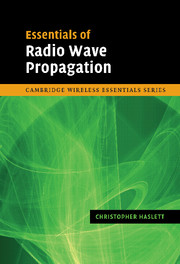Crossref Citations
This Book has been
cited by the following publications. This list is generated based on data provided by Crossref.
Britton, Matthew
and
Coyle, Andrew
2011.
Modelling radio propagation and contention in emulated defence networks.
p.
1.
Monsalve, Mauricio
Pemmaraju, Sriram
and
Polgreen, Philip M.
2013.
Interactions in an intensive care unit.
p.
1.
2015.
Spectrum Management.
p.
24.
Li, Wei
Qian, Zhaojun
and
Li, Huiyu
2016.
Interpretation and Classification of P-Series Recommendations in ITU-R.
International Journal of Communications, Network and System Sciences,
Vol. 09,
Issue. 05,
p.
117.
2017.
Three-Tier Shared Spectrum, Shared Infrastructure, and a Path to 5G.
p.
79.
Poole, Greg
2018.
Cosmic Wireless Power Transfer System and the Equation for Everything <i>E</i>=<i>mc</i><sup>2</sup>=<i>vc</i><sup>2</sup>/60=<i>a</i><sup>3</sup>/<i>T</i>=<i>G</i>(<i>M</i><sub>1</sub>+ <i>M</i><sub>2</sub>)/4&pi;<sup>2</sup>=(<i>KE</i>+<i>PE</i>)/1.0<i>E</i>15=<i>Q</i>=<i>PA</i>/<i>F</i>=<i>λ</i>/<i>hc</i>=1/2<i>q</i>=<i>VI</i>=1/2<i>LI</i><sup>2</sup>=1/2<i>CV</i>=<i>I</i><sup>2</sup><i>R</i>=….
Journal of High Energy Physics, Gravitation and Cosmology,
Vol. 04,
Issue. 04,
p.
588.
Aziz, M. A.
and
Allen, C. T.
2018.
Experimental Results of a Differential Angle-of-Arrival Based 2D Localization Method Using Signals of Opportunity.
International Journal of Navigation and Observation,
Vol. 2018,
Issue. ,
p.
1.
Brown, Suzana
and
Mickelson, Alan
2018.
A Decision Framework for Choosing Telecommunication Technologies in Limited-Resource Settings.
Future Internet,
Vol. 10,
Issue. 1,
p.
8.
Díaz, Camilo A. R.
Leitão, Cátia
Marques, Carlos A.
Alberto, Nélia
Domingues, M. Fátima
Ribeiro, Tiago
Pontes, Maria J.
Frizera, Anselmo
Antunes, Paulo F.C.
André, Paulo S.
and
Ribeiro, Moisés R.N.
2019.
IoToF: A Long-Reach Fully Passive Low-Rate Upstream PHY for IoT over Fiber.
Electronics,
Vol. 8,
Issue. 3,
p.
359.
Akbar, M. F.
Mahardika, D.
Rizqi, M.
Sulthoni, M. A.
and
Moelyadi, M. A.
2021.
Avionics subsystems design and development for HALE UAV ITB V4.
Vol. 2366,
Issue. ,
p.
020012.
Wisiak, Katja
Jakić, Michel
and
Hartlieb, Philipp
2022.
Application of Ultra-Wide Band Sensors in Mining.
Sensors,
Vol. 23,
Issue. 1,
p.
300.
Yue, Liyang
Yan, Bing
Wang, Zengbo
Minin, Oleg V.
and
Minin, Igor V.
2023.
Photonic Hook Initiated Using an Air–Liquid Interface.
Photonics,
Vol. 10,
Issue. 10,
p.
1175.
Fano, Walter Gustavo
and
Gardella, Pablo Jesús
2024.
The method of images on lossless dielectric ground planes.
Physics Letters A,
Vol. 493,
Issue. ,
p.
129246.
Zhang, Yaguang
Krogmeier, James V.
Anderson, Christopher R.
and
Love, David J.
2024.
Large-Scale Cellular Coverage Simulation and Analyses for Follow-Me UAV Data Relay.
IEEE Transactions on Wireless Communications,
Vol. 23,
Issue. 3,
p.
2396.





